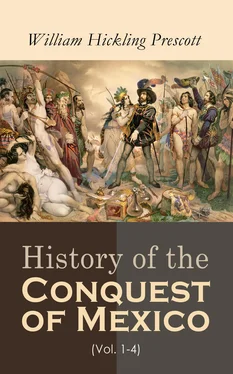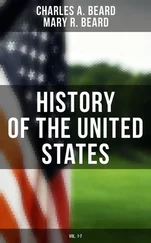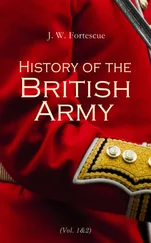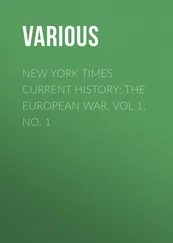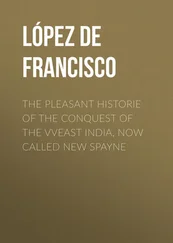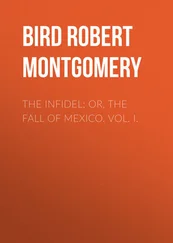Cortés was too content with the victory to care to follow it up by dipping his sword in the blood of the fugitives. He drew off his men to a copse of palms which skirted the place, and under their broad canopy the soldiers offered up thanksgivings to the Almighty for the victory vouchsafed them. The field of battle was made the site of a town, called, in honor of the day on which the action took place, Santa María de la Victoria , long afterwards the capital of the province. [554]The number of those who fought or fell in the engagement is altogether doubtful. Nothing, indeed, is more uncertain than numerical estimates of barbarians. And they gain nothing in probability when they come, as in the present instance, from the reports of their enemies. Most accounts, however, agree that the Indian force consisted of five squadrons of eight thousand men each. There is more discrepancy as to the number of slain, varying from one to thirty thousand! In this monstrous discordance the common disposition to exaggerate may lead us to look for truth in the neighborhood of the smallest number. The loss of the Christians was inconsiderable; not exceeding—if we receive their own reports, probably, from the same causes, much diminishing the truth—two killed and less than a hundred wounded! We may readily comprehend the feelings of the Conquerors, when they declared that “Heaven must have fought on their side, since their own strength could never have prevailed against such a multitude of enemies!” [555]
Several prisoners were taken in the battle, among them two chiefs. Cortés gave them their liberty, and sent a message by them to their countrymen “that he would overlook the past, if they would come in at once and tender their submission. Otherwise he would ride over the land, and put every living thing in it, man, woman, and child, to the sword!” With this formidable menace ringing in their ears, the envoys departed.
But the Tabascans had no relish for further hostilities. A body of inferior chiefs appeared the next day, clad in dark dresses of cotton, intimating their abject condition, and implored leave to bury their dead. It was granted by the general, with many assurances of his friendly disposition; but at the same time he told them he expected their principal caciques, as he would treat with none other. These soon presented themselves, attended by a numerous train of vassals, who followed with timid curiosity to the Christian camp. Among their propitiatory gifts were twenty female slaves, which, from the character of one of them, proved of infinitely more consequence than was anticipated by either Spaniards or Tabascans. Confidence was soon restored, and was succeeded by a friendly intercourse, and the interchange of Spanish toys for the rude commodities of the country, articles of food, cotton, and a few gold ornaments of little value. When asked where the precious metal was procured, they pointed to the west, and answered, “Culhua,” “Mexico.” The Spaniards saw this was no place for them to traffic, or to tarry in. Yet here, they were not many leagues distant from a potent and opulent city, or what once had been so, the ancient Palenque. But its glory may have even then passed away, and its name have been forgotten by the surrounding nations.
Before his departure the Spanish commander did not omit to provide for one great object of his expedition, the conversion of the Indians. He first represented to the caciques that he had been sent thither by a powerful monarch on the other side of the water, for whom he had now a right to claim their allegiance. He then caused the reverend fathers Olmedo and Diaz to enlighten their minds, as far as possible, in regard to the great truths of revelation, urging them to receive these in place of their own heathenish abominations. The Tabascans, whose perceptions were no doubt materially quickened by the discipline they had undergone, made but a faint resistance to either proposal. The next day was Palm Sunday, and the general resolved to celebrate their conversion by one of those pompous ceremonials of the Church, which should make a lasting impression on their minds.
A solemn procession was formed of the whole army, with the ecclesiastics at their head, each soldier bearing a palm-branch in his hand. The concourse was swelled by thousands of Indians of both sexes, who followed in curious astonishment at the spectacle. The long files bent their way through the flowery savannas that bordered the settlement, to the principal temple, where an altar was raised, and the image of the presiding deity was deposed to make room for that of the Virgin with the infant Saviour. Mass was celebrated by Father Olmedo, and the soldiers who were capable joined in the solemn chant. The natives listened in profound silence, and, if we may believe the chronicler of the event who witnessed it, were melted into tears; while their hearts were penetrated with reverential awe for the God of those terrible beings who seemed to wield in their own hands the thunder and the lightning. [556]
The Roman Catholic communion has, it must be admitted, some decided advantages over the Protestant, for the purposes of proselytism. The dazzling pomp of its service and its touching appeal to the sensibilities affect the imagination of the rude child of nature much more powerfully than the cold abstractions of Protestantism, which, addressed to the reason, demand a degree of refinement and mental culture in the audience to comprehend them. The respect, moreover, shown by the Catholic for the material representations of Divinity, greatly facilitates the same object. It is true, such representations are used by him only as incentives, not as the objects of worship. But this distinction is lost on the savage, who finds such forms of adoration too analogous to his own to impose any great violence on his feelings. It is only required of him to transfer his homage from the image of Quetzalcoatl, the benevolent deity who walked among men, to that of the Virgin or the Redeemer; from the Cross, which he has worshipped as the emblem of the god of rain, to the same Cross, the symbol of salvation.
These solemnities concluded, Cortés prepared to return to his ships, well satisfied with the impression made on the new converts, and with the conquests he had thus achieved for Castile and Christianity. The soldiers, taking leave of their Indian friends, entered the boats with the palm-branches in their hands, and, descending the river, re-embarked on board their vessels, which rode at anchor at its mouth. A favorable breeze was blowing, and the little navy, opening its sails to receive it, was soon on its way again to the golden shores of Mexico.
Table of Contents
VOYAGE ALONG THE COAST—DOÑA MARINA—SPANIARDS LAND IN MEXICO—INTERVIEW WITH THE AZTECS
1519
THE fleet held its course so near the shore that the inhabitants could be seen on it; and, as it swept along the winding borders of the Gulf, the soldiers, who had been on the former expedition with Grijalva, pointed out to their companions the memorable places on the coast. Here was the Rio de Alvarado , named after the gallant adventurer, who was present also in this expedition; there the Rio de Vanderas , in which Grijalva had carried on so lucrative a commerce with the Mexicans; and there the Isla de los Sacrificios , where the Spaniards first saw the vestiges of human sacrifice on the coast. Puertocarrero, as he listened to these reminiscences of the sailors, repeated the words of the old ballad of Montesinos, “Here is France, there is Paris, and there the waters of the Duero,” [557]etc. “But I advise you,” he added, turning to Cortés, “to look out only for the rich lands, and the best way to govern them.” “Fear not,” replied his commander: “if Fortune but favors me as she did Orlando, and I have such gallant gentlemen as you for my companions, I shall understand myself very well.” [558]
Читать дальше
